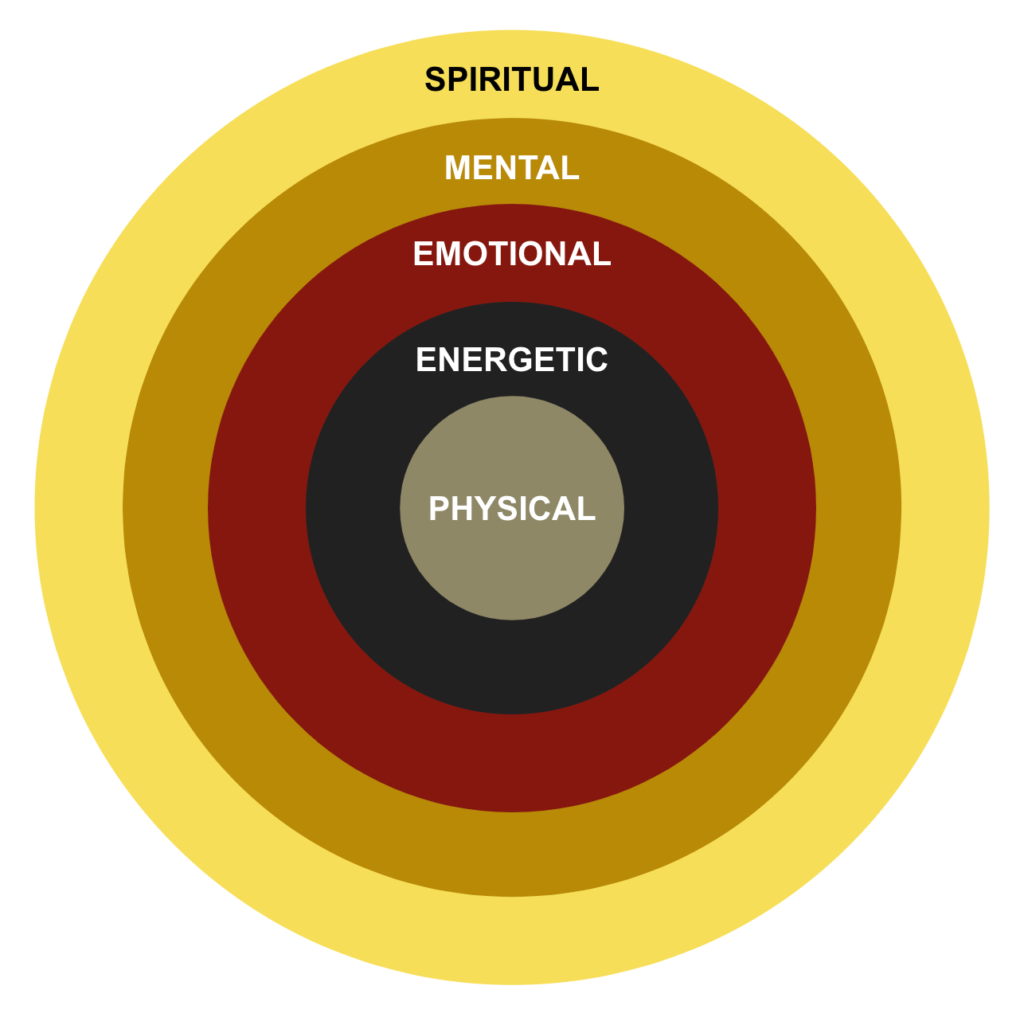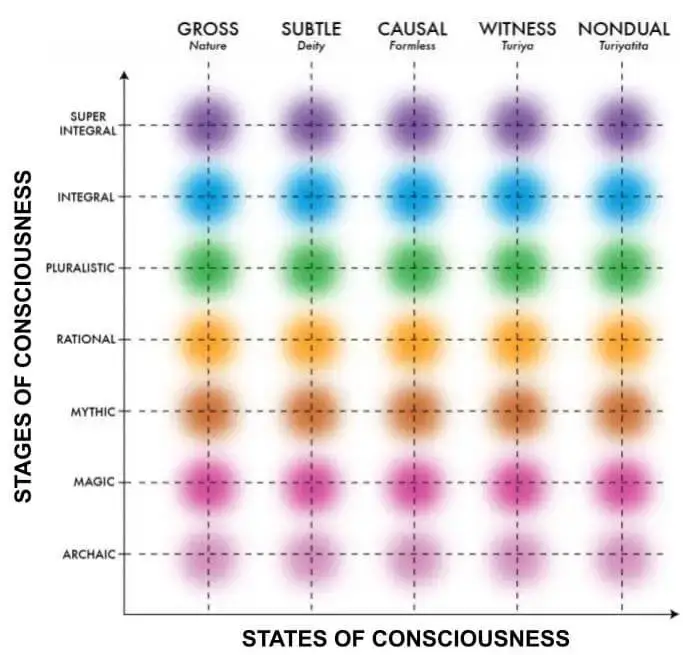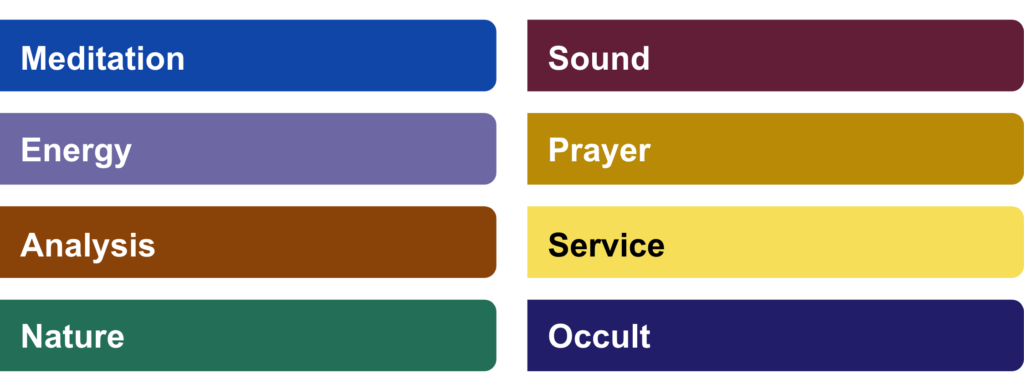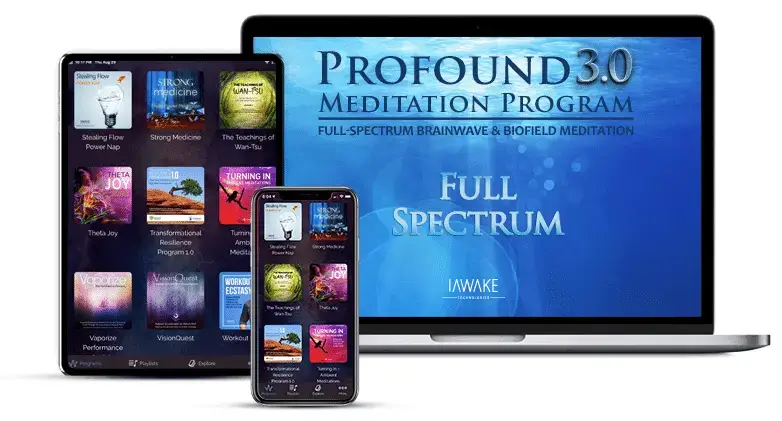Welcome to the world of spiritual practices, a world of intrigue, exploration, discovery, and pitfalls.
A vast ocean of practices exists in this world. In fact, a list of over 200 spiritual practices is highlighted below.
To navigate the realm of spiritual practices, this in-depth guide presents a holistic framework for exploring and understanding the various types of disciplines and techniques available to you.
What you choose and where you go from here is up to you.
Let’s dive in …
What are Spiritual Practices?
How do we define a spiritual practice?
At the most basic level, spiritual implies “of the spirit.” As such, a spiritual practice would be any method or exercise that helps an individual move toward the Spirit.
But this definition triggers two related questions:
- Who or what exactly is moving toward the Spirit?
- What do we mean by the term “Spirit”?
Let’s briefly address both of these questions …
The Practitioner
From a psychological viewpoint, the individual who engages in spiritual practices represents the ego (synonymous with the self, with a small “s”).
The ego is a complex set of identifications, conditioning, opinions, positions, desires, preferences, and judgments. It’s our perceived self-identity or sense of self.
From the viewpoint of the ancient traditions, this small self is ultimately considered a false self. Spiritual practices are designed to help individuals realize this.
The Meaning of Spirit
The Spirit is known by many different names, depending on the tradition and the context in which the term is used.
The Self (capital “S”) is a standard term related to Spirit.
In psychology, related terms include Higher Self, True Self, Authentic Self, or Inner Self. All of these terms are used in contrast to the concept of the small self or ego.
In Western religions, the most common terms for Spirit are God, Divinity, or the Holy Spirit.
In the Eastern traditions, the Spirit or Self is referred to as:
- Original Spirit
- Original Nature
- Original Face
- Oversoul
- Purusha
- Atman
- Brahman
For example, in Taoism, the concept of the Conscious Spirit (or ego-self) is contrasted with the Original Spirit (or Self).
We might think of the Spirit as an all-pervading, inner Divine center within one’s consciousness.
The Primary Function of Spiritual Practices
Now that we’ve addressed the above two questions, let’s clarify:
What’s the purpose or goal of spiritual practices?
The purpose of spiritual practices and disciplines is to realize a higher state of consciousness beyond the mundane everyday state of the ego (small s).
Standard terms used within the traditions include Self-realization, enlightenment, and self-liberation (Moksha).
Each of the Wisdom traditions provides a complex set of spiritual practices—called sadhanas in Hinduism, for example—to assist the individual (spiritual aspirant) in achieving this goal.
In Carl Jung’s terminology, the goal was to attain the Transcendent Function of the Self, considered the ultimate objective of his individuation process.
Psychologist Abraham Maslow referred to this state as Self-Transcendence.
Exoteric Religion vs Spiritual Practice
When an exoteric religion is taken at face value, its stories and teachings are generally assimilated only on a conceptual or intellectual level (based on hearsay or dogma).
Hearing these stories and teachings at a young age, these messages form a system of beliefs that many individuals maintain throughout their adult lives.
In contrast, with spiritual practices, the intention is to realize the meaning of these teachings (or potentially invalidate them) through one’s direct experience.
In this way, spiritual practices can provide a means for “phenomenological research” without preconceived notions, thereby transcending hearsay and beliefs. As such, effective spiritual practices can be very powerful.
Note: Click here to skip directly to the spiritual practices list.
Spiritual Practices within a Holistic Framework
It’s practical to view spiritual practices within some overall framework.
Any such framework provides a “holistic view” for how to approach various methods. Different practices and spiritual disciplines activate and develop multiple aspects of our being.
Each Wisdom tradition viewed the total being as a composite of different bodies, qualities, or dimensions.
In the simplest terms, we might have a framework of body, mind, and spirit.
The Five Koshas
For example, in the Yogic tradition, they have what’s called the five koshas or sheaths:
- Food sheath (Annamaya)
- Vital energy sheath (Pranayama)
- Mental sheath (Manomaya)
- Intellect sheath (Vijnanamaya)
- Illumined sheath (Anandamaya)
Each sheath represents a body. In order:
- Physical body
- Energy body
- Emotional body
- Wisdom body
- Bliss body
These body-sheaths also represent veils that are meant to be transcended, leading one to the illumined sheath—the Spiritual Body or Self.
The Three Treasures
Taoism provides a simpler framework with its Three Treasures model. The Three Treasures are:
- Jing – the life essence of the body
- Qi – the body’s energetic system
- Shen – Spirit or consciousness
So, once again, we see layers of “sheaths” or bodies that ladder up to Spirit:
- Jing represents the physical body (especially the vital organs where the Jing is stored).
- Qi represents the energetic body, encompassing all its meridians, pathways, and fields.
- Shen represents the Spirit body, or the higher consciousness within.
At the very least, effective spiritual practices will address the above three bodies.
The spiritual practices within these traditions are designed to address each of these bodies, restoring and improving their functioning in such a way that spiritual evolution becomes a natural and spontaneous process.
As we explore the spiritual practices listed below, notice how each type of practice addresses different dimensions of our overall being.
The Wilber-Combs Lattice
States versus Stages
For our purposes here, one last, but vital insight from transpersonal psychology is the differentiation between:
- States of Consciousness
- Stages of Consciousness
Understanding the difference between states and stages is essential for effective, long-term practice.
Altered States of Consciousness
Many spiritual practices can trigger altered or “higher” states of consciousness. A noticeable change in perception from your normal, daily waking state defines an altered state.
Altered states of consciousness are temporary. These altered states can be revelatory and insightful. However, they don’t, for the most part, change the structure of your consciousness.
Higher Stages of Consciousness
In contrast, other spiritual disciplines and practices are designed to change the very structure of one’s consciousness over time.
These structural changes tend to be permanent. That is, once a new structure within one’s consciousness is established, the individual doesn’t return to the prior structure.
Illustrations of States and Stages
Taking psychedelics or experiencing religious fervor during a Church ceremony are examples of altered states.
Your experiential reality is altered, potentially leading to experiences of joy, elevation, and higher realizations.
However, after the substance wears off or the religious gathering ends, you eventually return to a similar state as you were in before the peak experience.
In contrast, meditating collectively for thousands of hours can produce structural changes in one’s consciousness.
Over time, your perception of reality changes. You react differently to outside and internal stimuli. You see things differently. As such, your understanding and behavior tend to change.
Most children have some experiences with higher states of consciousness. Stabilizing within those higher states, however, generally requires consistent discipline of spiritual practices over time.
8 Types of Spiritual Practices
Before presenting a comprehensive list of spiritual practices, it will be beneficial to categorize these practices into related groups.
Doing so helps reduce a large number of practices into a manageable set of types. These types include:
- Meditative practices
- Energetic practices
- Analytical methods
- Nature-inspired practices
- Sound-based practices
- Prayer-centered practices
- Service-oriented practices
- Occult practices
Although there are hundreds, if not thousands, of spiritual practices, they can be mainly categorized into one of these eight categories.
Now, let’s break down each group.
Meditative Practices
Meditative practices and disciplines comprise a vast category within the Wisdom traditions. All forms of meditation fall into this massive category.
Meditation is a practice that cultivates one’s attention and focus. Meditative practices are designed to quiet the mind, and in some cases, transcend it.
Every wisdom tradition offers a multitude of specific meditative practices for accomplishing this, including sitting meditations, standing meditations, walking meditations, contemplation, and self-reflection.
These practices often involve focusing one’s attention on various “objects,” including:
- The breath
- Region of the body
- A mantra
- A quality within the mind
- The sense of one’s being
Extensive research shows that long-term meditation (cumulative over time) fundamentally changes one’s brain and leads to many health benefits as well. Different forms of meditation develop one’s cognitive faculties in varying ways.
Energetic Practices
Energetic practices generally help relax and open the body, allowing its natural vital energy to flow freely. Virtually all advanced and integrated systems include body-oriented and energetic practices to support mind-based disciplines.
Examples of energetic practices include specific types of breathwork, movements, postures, and hand mudras. The Yoga system from India, including Kundalini Yoga, and the Taoist system, including Qigong, Neigong, and Neidan, are the most relevant examples.
These schools provide intricate methods and practices for cultivating the native energy stored within the body. The internal martial systems from China are also based on these principles, including the three sister forms: Tai Chi, Bagua, and Hsing-Yi.
Fasting is another common spiritual practice used to help purify the blood and organs while stimulating the energy body.
Even a practice like solitude can be perceived as an energetic practice. Spending a great deal of time alone in silence can help an individual restore their energetic field.
Analytical Methods
While meditation helps cultivate attention and stabilize the mind, analytical methods allow us to refine it.
The ancient traditions are rich in analytical insights derived from self-analysis. The masters of these traditions were brilliant, self-taught psychologists, as they carefully observed their behavior and that of others over extended periods.
Chan Buddhism, for example, provides detailed methods for getting to the core of desire, helping one understand how it arises.1See, Chih-i, Thomas Cleary (Trans), Stopping and Seeing, 1997. Tibetan Buddhism offers a comprehensive mind training program called Lojong that highlights a great deal about our tendencies and behaviors.2https://www.goodreads.com/list/show/33015.Tibetan_Buddhism_Lojong_Mind_Training
More recent analytical methods were developed by depth psychology and later iterations. Examples include shadow work, active imagination, dream analysis, and other forms of inner work.
Analytical approaches often involve differentiating oneself from the archetypes of the unconscious, what the traditions referred to as “ghosts and spirits,” helping one move toward the Self/Spirit.
Nature-Inspired Practices
Nature-inspired practices enable individuals to transcend their small self (ego) and connect with the natural world. Nature-based methods are often used in conjunction with the other practices highlighted here.
Examples of nature-based exercises include sun gazing and grounding techniques. Simply walking outside, appreciating plant and animal life, or communing with nature all qualify for this category.
Psychedelics or entheogenic substances are also technically nature-based practices. Ancient Shamans, adepts, and mystery schools utilized specific plants and herbs with psychoactive properties to induce altered states of consciousness. Ayahuasca ceremonies are one example.
Note: If you have any history of mental illness, consider avoiding psychedelics as they can trigger latent psychosis hidden within one’s psyche.
Sound-Based Practices
Virtually all the Wisdom Traditions also use sound-based spiritual practices. Group chanting and individual (audible) mantras are used to induce altered and higher states of consciousness.
Eastern monasteries often employ gongs, bells, and bowls calibrated to specific frequencies to facilitate the induction of altered states of consciousness. Catholic churches and cathedrals use massive organs to achieve a similar effect.
In Qigong, the practitioner produces specific sounds to vibrate at the particular frequency associated with each organ (Six Healing Sounds). In sound healing therapies, all of the above are utilized, along with tuning forks and other innovative, frequency-based tools.
Prayer-Centered Practices
Prayer-centered spiritual practices are designed to invoke the Divine, either externally or within oneself.
Prayer-based methods are often used by individuals on a devotional path (called Bhakti Yoga in the Hindu tradition).
Prayer may be directed to one’s God, a guru, or to a higher quality within oneself (for example, purity or beingness).
Prayer often involves the repetition of a particular Holy passage (for example, The Lord’s Prayer) or a mantra used to influence your subconscious mind.
Service-Oriented Practices
Service-based practices are designed to help individuals prioritize the needs of others over their own.
Serving others can be a means of reducing the sense of importance of an individual’s ego, while seeing oneself in others (regardless of one’s race, ethnicity, religious affiliation, or other belief systems).
The goal of service-oriented spiritual practices is to take action without egoic intent (personal gain) or attachment to the outcome. (For example, if you “help” someone because you secretly want praise or acknowledgement, you are servicing the ego.)
In the Yoga system, this is called Karma Yoga.
Occult Practices
The ancient traditions, as well as the New Age, also offer a wide range of occult practices. “Occult” means hidden; it often refers to secretive or supernatural knowledge and insights.
This spiritual practice category encompasses the metaphysical (beyond the physical), sometimes involving access to the etheric or astral domain.
Divination practices were common in ancient traditions. For example, the Taoist I-Ching (Book of Change) provides a powerful means of understanding the nature of repeating cycles.
Occult practices in the New Age include astral travel, out-of-body experiences, Tarot cards, channeling, drum circles, astrology, and various forms of ritual.
Technically, ancient tantric practices would also be included within this category.
Photo by Jeremy Bishop | Unsplash
Spiritual Practices Listed by Category
Before reviewing a master list of spiritual practices, let’s examine a list of different religious systems and their associated spiritual practices.
It’s important to note that each major religious branch has a range of schools within it.
For example, within Buddhism, there are various traditions, including Southern Buddhism, Mahayana Buddhism, Tantric Buddhism, Tibetan Buddhism, and Chan Buddhism, among others.
Within Taoism, there are various schools, including the Northern Reality School, the Southern Reality School, and the Complete Reality School. The same applies to each tradition.
Religious and spiritual systems include:
- Buddhism
- Hinduism
- Christianity
- Taoism
- Confucianism
- Judaism
- Islamism
- Shamanism
- New Ageism
- Paganism
- “Secular spirituality”
Meditation Practices List
The variety of meditation practices found within the wisdom tradition is extensive, and many “modern” versions are available as well. These meditative spiritual practices include:
- Mantra-based meditation
- Observer meditation
- Mindful breathing meditation (Anapanasati)
- Zen meditation (Zazen)
- Vispanna meditation
- Loving-kindness meditation (Metta)
- Calm-abiding meditation (Samatha)
- Heart-based meditation (Bodhicitta)
- Chakra meditation
- Body scan (mindfulness technique)
- Focused meditation
- Compassion meditation
- Reflection meditation
- Contemplation meditation
- Yoga meditations
- Mindfulness meditation
- Mindfulness-Based Stress Reduction (MBSR)
- Movement meditation
- Guided meditation
- Visualization meditation
- Candle-gazing meditation
- Walking meditation (Kinhin)
- Meditation on impermanence
- Transcendental meditation (TM)
- Progressive Muscle Relaxation (PMR)
- Seventeen Tantras
- Vajrayana meditation
- Trataka Meditation (also spelled tratak)
- Mandala meditation
See also: 5 Powerful Meditation Tools to Help You Train Your Mind
List of Breathing Techniques
Similarly, the wisdom traditions are rich in a variety of breathing techniques designed to help calm the body and mind. New variations of these ancient methods have also been developed.
- Diaphragmatic breathing (balloon breathing)
- Deep belly breathing
- Natural breathing
- Reverse breathing
- Alternate nostril breathing (Nadi Shodhana)
- Victorious breath (Ujjayi)
- Skull Shining Breath (Kapalabhati)
- Lion’s breath
- Three-Part Breath
- Buddha’s Breath
- Resonant breathing
- Humming bee breath (Bhramari)
- Breath counting
- Pranayama breathing
- Holotropic breathing
- Pursed lip breathing
- Breath focus technique
- Sitali breath
- 4–7–8 breathing technique
- Sufi Whirling
- Heart Centered Breathing
List of Mantra Practices
Mantras play a vital role in many spiritual traditions. They are often used in conjunction with meditation.
- Bija Mantras (Seed mantras like Om)
- Sanskrit Mantras (Gayatri and Maha Mrityunjaya Mantra)
- Prayer Mantras
- Chakra Mantras
- Saguna Mantras (Mantras with Form)
- Nirguna Mantras (Mantras without Form)
- Japa Mantras (Repetitive Mantras)
- Shlokas (Verse Mantras)
- Various Affirmations
List of Common Prayer-Based Practices
Prayer-centered spiritual practices include:
- Prayer of Intercession
- Prayer of Blessing and Adoration
- Prayer of Thanksgiving
- Prayer of Petition
- Repenting prayer
- The Lord’s Prayer
- Listening prayer
- Prayer of the Holy Spirit
- Prayer of consecration
- Prayer of agreement
- Prayer of faith
- Centering prayer
- Healing prayer
- Liturgical prayer
- Prayer of worship
- Confession
- Affirmation prayer
- Prayer for others
- Contemplative prayer
- Imprecatory Prayer
- Guidance prayer
- The prayer of agreement (also known as corporate prayer)
- The prayer of request (or supplication)
- Meditative Prayer
A Powerful Tool to Enhance Your Meditation Practice
Years ago, I experimented with most brainwave entrainment programs on the market, but iAwake’s sound technology is unique.
iAwake’s programs go beyond traditional brainwave entrainment technology to incorporate what they call biofield entrainment, harmonic layering, dual-pulse binaural signaling, and other advanced methods.
These sound technologies are embedded in the background. You mainly hear various soundscapes (mostly rain/stream sounds).
Profound Meditation Program 3.0
The Profound Meditation Program 3.0 (PMP) is a comprehensive brainwave entrainment program that features a robust 3-tier system. You listen to the tracks in blocks of 20 minutes. With a headset, the sounds play in the background as you meditate.
PMP is a potent meditation training tool that can produce psychoactive experiences. In my opinion, especially if you’re new to meditation, this is one of the best tools you can use to start experiencing results. It can help you focus and deepen your practice.
Experience Profound Meditation Program 3.0 for Free
If you want to give PMP a test drive…
Download a free 20-minute track from this program here (along with other free tracks).
If you decide to invest in PMP 3.0, use code CEOSAGE25 to receive a 25% discount.
Disclaimer: Affiliate links above.
Photo by Dave Contreras
Spiritual Practices List by Tradition
Using the list of religious systems above, let’s review examples of spiritual practices within each tradition.
Types of Yogas
The Yogic system in India is one of the oldest and most robust in the world.
In Yoga philosophy, there are “four paths” to realize enlightenment, or Self-realization:
- Karma Yoga
- Bhakti Yoga
- Rāja Yoga
- Jñāna Yoga
Each path offers a distinct means of connecting with Spirit/Self/God. Each path utilizes a variety of principles and spiritual practices to realize the Self.
Karma Yoga
Karma Yoga is the path of action (“right action” or “selfless service”). It’s a function of doing your “duty” for the sake of doing it, rather than doing things to feed our egos (self-identity) and personal attachments.
Bhakti Yoga
Bhakti Yoga is the path of devotion. In this Yoga, devotion is mainly to purity or sattva. With Bhakti Yoga, spiritual practices are performed to purify oneself to reach Self-realization.
Rāja Yoga
Rāja Yoga is the path of control. That is, this path involves controlling one’s ego, encompassing the mind (with all its thoughts and impulses), the physical body, the senses, and the breath.
Jñāna Yoga
Finally, Jñāna Yoga is the path of knowledge. It’s the path of Self-knowledge, using self-observation, self-analysis, and awareness to transcend the ego and realize the Self. See this guide on nonduality for an in-depth introduction to Jñāna Yoga.
This article provides a detailed overview of each path referenced above.
Other Types of Yoga
Types of Yoga include:
- Hatha Yoga
- Vinyasa Yoga
- Ashtanga Yoga
- Iyengar Yoga
- Yin Yoga
- Restorative Yoga
- Kundalini Yoga
- Bikram Yoga
- Sivananda Yoga
- Prenatal Yoga
- Yoga Nidra
In general, Yoga illustrates the integrative nature of these wisdom traditions. Sets of practices include:
- Moral codes (yama)
- Self-purification exercises (niyama)
- Postures (asana)
- Breathing practices (pranayama)
- Ways to withdraw the senses (pratyahara)
- Focused concentration (dharana)
- Meditation (dhyama)
- Union with Spirit (samadhi)
You’ll find similar categories of spiritual practices in other ancient traditions.
List of Taoist Practices
The Taoist system emphasizes the importance of cultivating the energy body.
There are literally thousands of Taoist spiritual practices. Within Qigong alone, there are reportedly 3,600 exercises.
Qigong practices are often separated into three groups:
- Qigong for health
- Qigong for martial arts
- Qigong for spiritual development
Qigong for health, designed to restore the body, sets the foundation for more advanced spiritual practices later on.
Providing a comprehensive list of Taoist practices is beyond the scope of this guide; however, examples include:
- Bigu (grain avoidance)
- Wuji Gong (Primordial Qigong)
- Microcosmic Orbit
- Macrocosmic Orbit
- Taoist meditation
- Neigong
- Neidan firing process
- Embryonic breathing
- Daoyin (Tendon Stretching)
- Tai Chi
- Bagua
- Hsing-Yi
- Swimming Dragon
- Ba Duan Jin (8 Pieces of Brocade)
- Bone Marrow Washing
- Five Animals
- Six Healing Sounds
- Five Elements Qigong
- Sleeping Qigong
- Golden Flower
- Zi Fa Qigong
- Zhan Zhuang
List of Buddhist Spiritual Practices
Similar to Hinduism and Taoism, Buddhism provides a rich tapestry of spiritual practices, with an emphasis on meditation:
- Insight meditation (Vipassanā)
- Calm-abiding meditation (Samatha)
- Loving-kindness meditation (Metta)
- Mindfulness practices
- Walking meditation
- The Eightfold Path
- Generosity (Dana)
- Bowing (for respect and humility)
- Chanting
- Mantras
- Offerings of devotion
Christian Practices List
Within Christianity, standard spiritual practices include:
- Meditating on God’s word
- Prayer (communing with God)
- Studying scripture
- Spiritual fasting
- Spending time alone with god (solitude)
- Submission
- Service to help others
- Confession
- Worship
- Fellowship
- Chastity
Spiritual Practices List in Confucianism
Practices within the Confucian system include:
- Cultivating virtues
- Ritual propriety (etiquette)
- Filial piety (respect for parents and elders)
- Ancestor veneration (honoring the deceased)
- Self-cultivation
- Bowing
- Righteousness (Yi)
- Rituals and ceremonies
- Divination (Yijing; yarrow-stalk divination)
Jewish List of Practices
A list of practices within Judaism includes:
- Prayer
- Torah study
- Observing Shabbat
- Keeping Kosher (dietary law)
- Mussar (character development)
Islamic Practices List
Standard Islamic spiritual practices include:
- Prayer (Salah)
- Remembrance of God (Dhikr)
- Repentance (Tawbah)
- Charity (Sadaqah)
- Patience (Sabr)
List of Shamanic Spiritual Practices
A list of spiritual practices within Shamanism includes:
- Spirit communication (spirit guides and animal spirits)
- Shamanic journeying (traveling to other realms in an altered state)
- Soul retrieval (a healing practice to recover from trauma)
- Shamanic divination
- Shamanic offerings (to the spirit world)
- Sound healing
- Dreamwork
New Age Practices List
The number of so-called “New Age” practices is considerable. Many of these practices and fields are adapted from more ancient methods.
However, I feel compelled to offer a brief warning about new ageism. While it has become immensely popular over the last 30 years or so, the roots of new ageism are suspect.3For example, if you look into Lucis Trust (originally Lucifer Trust) and the role of Alice Bailey, Helena Blavatsky, and so on, there’s reason for concern.
Also, many of its practices are cautioned against in ancient traditions for specific reasons. For example, channeling or any practice that leaves you vulnerable to etheric entities is generally discouraged by the traditions.
That said, the new age does offer a host of spiritual practices to explore, including:
- Divination (like Tarot)
- Rituals
- Channeling (mediumship)
- Bodywork
- Energy healing
- Crystal Healing
- Chakra cleaning
- Drum circles
- Biofeedback
- Mantras/chanting
- Connecting with angels, deities, and entities
- Third eye activation
- Aromatherapy
- Feng Shui
- Law of Attraction
- Sacred Nature
- Astrology
- Numerology
- Centering Prayer
- Astral travel
Pagan Practices List
Spiritual practices found within paganism include:
- Ancestor reverence
- 5-element rituals in nature
- Divination practices (like Tarot reading)
- Creative expression (arts, music, herbalism)
- Season festivals (celebrating the solstices and equinoxes)
- Creating home shrines
- Meditation or contemplation
List of Secular Spiritual Practices
So-called secular spiritual practices comprise basically the practices highlighted above. The difference is that there’s no exoteric religion or mythology associated with them.
For example, practicing mindfulness meditation or Qigong does not require a belief system or mythological framework. Secular spiritual practices tend to focus on personal growth.
Ultimately, the goal remains the same: to move toward something greater than oneself or to experience the interconnectedness of all things.
I’ll avoid listing these practices here, as it would be a repetition of what’s covered above.
Mandala from Sera Monastery
A Master List of Spiritual Practices
Okay, now we’re ready to review a master list of spiritual practices:
4-7-8 Breath
Aboriginal Walkabout
Acro Yoga
Active imagination
Active Journaling
Aerial Yoga
Affirmation Prayer
Affirmations
Alternate Nostril Breathing
Ancestor Veneration
Anapanasati (mindful breathing)
Aromatherapy
Ashtanga Yoga
Astral Travel
Astrology
Aya Ceremonies
Ba Duan Jin (8 Pieces of Brocade)
Bagua
Benevolence (Ren)
Bible Study
Bigu Qigong (grain avoidance)
Bija Mantras (Seed mantras)
Bikram Yoga
Biofeedback
Bodhicitta Meditation
Body Scan (mindfulness)
Bone Marrow Washing
Bowing
Breath Counting
Breath Focus Technique
Buddha’s Breath
Candle-Gazing Meditation
Centering Prayer
Chakra Cleansing
Chakra Mantras
Chakra Meditation
Channeling (mediumship)
Chanting
Cloud of Unknowing
Compassion Meditation
Confession
Connecting with Dieties
Contemplation Meditation
Contemplative Prayer
Crystal Healing
Cultivating Virtue
Dao Yin (Tendon Stretching)
Deep Belly Breathing
Dharana (focused concentration)
Dhikr (remembrance of God)
Diaphragmatic Breathing
Divination
Drawing Mandalas
Dream Work
Drum Circles
Embryonic Breathing
Energy Healing
Feng Shui
Filial Piety (Xiao)
Five Animals
Five Elements Qigong
Focused Breathing Meditation
Golden Flower
Gratitude Journaling
Grounding
Guidance Prayer
Guided Meditation
Guru Devotion
Hatha Yoga
Healing prayer
Heart Centered Breathing
Holotropic Breathing
Humming Bee Breath (Bhramari)
Ignatian Exercises
Imprecatory Prayer
Inner work
Internal Family Systems
Internal Martial Arts
Iyengar Yoga
Japa Mantras (Repetitive Mantras)
Kapalabhati (Skull Shining Breath)
Kundalini Yoga
Law of Attraction
Lectio Divina
Letting Go
Lion’s Breath
Listening Prayer
Listening to Gongs
Liturgical Prayer
Lojong Mind Training
Macrocosmic Orbit
Mandala Meditation
Mantra-Based Meditation
Mantras
Meditation on Impermanence
Meditative Prayer
Metta (Loving-Kindness) Meditation
Microcosmic Orbit
Milagros
Mind Training
Mindfulness-Based Stress Reduction
Movement Meditation
Mussar
Naikan Therapy
Natural breathing
Nature Appreciation
Neidan Firing Process
Neigong
Nirguna Mantras (Mantras w/o Form)
Numerology
Observer Meditation
Practicing Patience
Pranayama breathing
Prayer for others
Prayer Mantras
Prayer of agreement
Prayer of Agreement (Corporate Prayer)
Prayer of Blessing and Adoration
Prayer of Consecration
Prayer of Faith
Prayer of Intercession
Prayer of Petition
Prayer of Request (Supplication)
Prayer of Thanksgiving
Prayer of the Holy Spirit
Prayer of Worship
Prenatal Yoga
Present-Moment Meditation
Primordial Qigong (Wuji Gong)
Processing Grief
Progressive Muscle Relaxation (PMR)
Psychedelic Journeys
Psychosynthesis
Pursed Lip Breathing
Recovering from Addiction
Reflection Meditation
Releasing Emotions
Remembrance of God
Renunciation
Repeating the Names of God
Repenting Prayer
Resonant Breathing
Restorative Yoga
Reverse Breathing
Right Action
Right Concentration
Right Effort
Right Intent
Right Livelihood
Right Mindfulness
Right Speech
Right Understanding
Righteousness (Yi)
Ritual Propriety (etiquette)
Rituals
Shabbat (observance)
Sabr (patience)
Sacred Nature
Sadaqah (charity)
Saguna Mantras (Mantras with Form)
Salah (prayer)
Samatha (calm-abiding) Meditation
Sanskrit Mantras
Saying Grace
Self-Cultivation
Self-Expressive Art
Self-Reflection
Self-Therapy
Seventeen Tantras
Shadow Work
Shamanic Journeying
Shamanic Offerings
Shaolin Training
Shlokas (Verse Mantras)
Sitali Breath
Sivananda Yoga
Six Healing Sounds
Sleeping Qigong
Spontaneous Dance
Solitude
Soul Retrieval
Sound Healing
Spirit Communication
Spiritual Fasting
Stillness
Studying Sacred Texts
Sufi Whirling
Sun Gazing
Swimming Dragon
Tai Chi
Tantric Practices
Taoist Meditation
Tarot
Tawbah (Repentance)
Tea Ceremony
The Lord’s Prayer
Three-Part Breath
Tonglen
Transcendental Meditation (TM)
Trataka Meditation
Ujjayi Breath (Victorious Breath)
Using Hand Mudras
Vajrayana Meditation
Vinyasa Yoga
Vision Quest
Vispanna Meditation
Visualization Meditation
Voice Dialogue
Walking in Nature
Walking Meditation (Kinhin)
Worship
Yijing (yarrow-stalk divination)
Yin Yoga
Yoga Meditations
Yoga Nidra
Zen Archery
Zen Art / Calligraphy
Zen Meditation (Zazen)
Zhan Zhuang
Zi Fa Qigong
Photo by Stephen Ellis | Unsplash
How to Approach Spiritual Practices for Beginners
If you’re just getting started with spiritual practices, here are a few things to help you build momentum:
1) Pay attention to what resonates with you
You may find yourself gravitating to specific practices and methods. This is often a positive indication.
2) Focus on the breath
Breathwork is foundational for virtually all other spiritual practices.
Training your body to breathe properly can help relax the body, calm the mind, and improve your focus and attention.
3) Incorporate body-mind practices
Most of us are relatively divorced from our bodies, mainly living in our minds instead.
Practices that combine body and mind, such as integrating movements with breathing, stretching with breathing, or sensing the body’s energy, strengthen one’s foundation and help to access the Center.
This body-mind integration will support later practices and development.
4) Stay present as you practice
It’s easy to lose focus on your practice, especially in the beginning. The mind begins to wander …
- What am I going to eat for dinner?
- What’s on TV tonight?
- What am I going to do this weekend?
- How am I going to afford …
When you start spiritual practices like meditation, every possible thought will enter your mind to avoid the task at hand.
Still, staying present with your practice is essential to facilitate progress and results.
5) Start small
Since being mindful is essential but challenging, take it one step at a time—small, incremental changes.
For example, start by practicing breathwork for only 60 seconds. Meditate for only two to five minutes. Do less initially, not more.
As with strength training, you can increase your repetitions and weights over time.
A 2-minute meditation may initially feel like a lifetime. However, after a few months of daily practice, a 20-minute meditation becomes comfortably attainable.
6) Focus on experiential results over study
Study is critical because it helps us develop our cognitive intelligence and language for understanding higher truths.
However, some individuals tend to focus too much on their studies. For example, studying ancient philosophical texts or reading the Bible daily.
While this may serve the individual from an intellectual perspective, it is arguably not representative of true practice (from a developmental standpoint).
Remember, valid practices produce experiential results.
For example, you can become very knowledgeable about meditation, learning the various types of practices, their history, and their benefits. However, until you apply discipline and willpower to meditate consistently, deepening your practice each day, no significant changes in your consciousness will likely occur.
7) Be patient
While peak experiences can occur at any moment, expecting them to happen or making them your primary goal can hinder your long-term practice and development.
Be patient with your daily practice. It’s a process. The fruits come with time and careful cultivation.
8) Cultivate will
As with any good habit, cultivating willpower is an essential aspect of committing to daily spiritual practices.
Set an initial goal of practicing each day, ideally at a specific time that’s convenient for you. Consider setting aside a specific area in your home for practicing. Set a timer, if that helps you.
For more effective strategies, refer to this in-depth guide on implementing positive changes.
9) Build genuine conviction
Practices can become stale over time. If they become like some other chore, the process will become mechanical and lifeless. As such, little progress will be made.
To prevent this from happening, build resolve, conviction, and faith in practice itself. Periodically remind yourself why you’re doing the particular practice. Practices infused with devotion, conviction, and faith become alive within us.
Practices done with misaligned intentions will eventually wither and die; no genuine growth will be realized. Examples of misaligned practice include:
- Doing an activity because someone else told you to do it
- Secretly practicing something (like meditation) to “get it done” or cross it off a to-do list
- Using practices to elevate your ego (posting images of you doing yoga on social media)
- Engaging in practices to fit into a social group (or your family)
That is, your intention driving your spiritual practice must be genuine: to better know and understand yourself, connect with the Self, transcend your mind, and so on.
Keep your practice alive within you!
Good luck!
Read Next
10 Signs of Authentic Spiritual Awakening
A Practical Guide to Spiritual Guidance (7 Approaches)


















I appreciated this release about spiritual practices. That integrative idea was new for me. It made me realize that many of them have been incorporated in my regular habits. From now on I will focus on deepening them.
Sure thing, Miguel. Sounds like a plan.